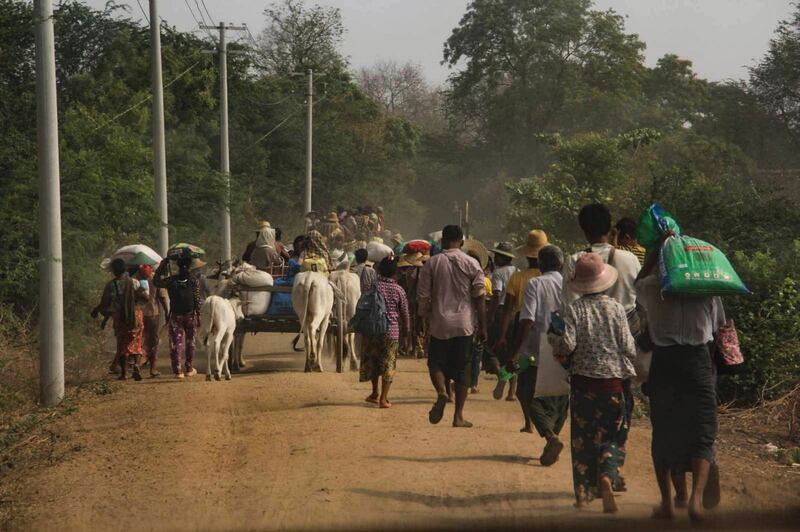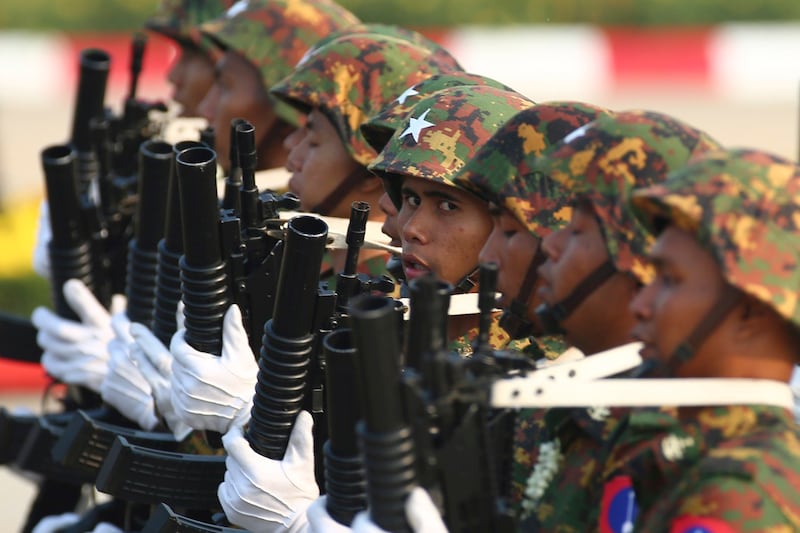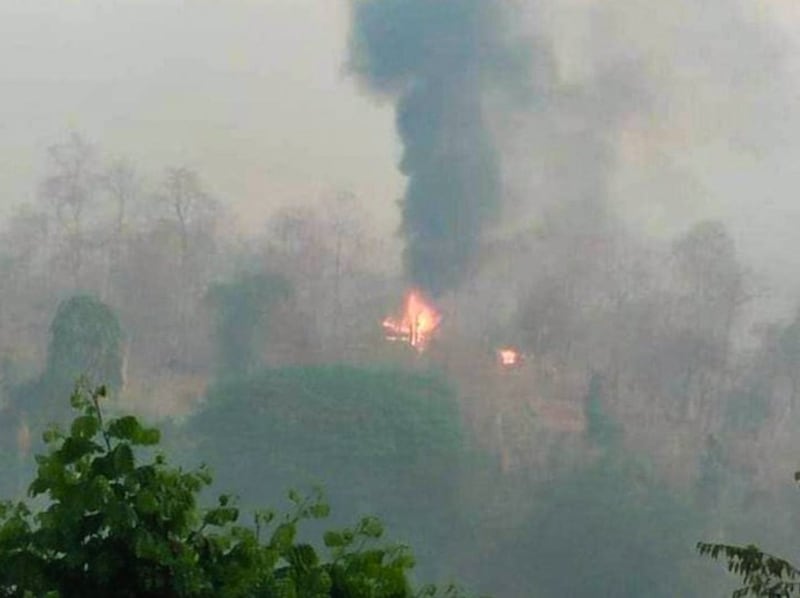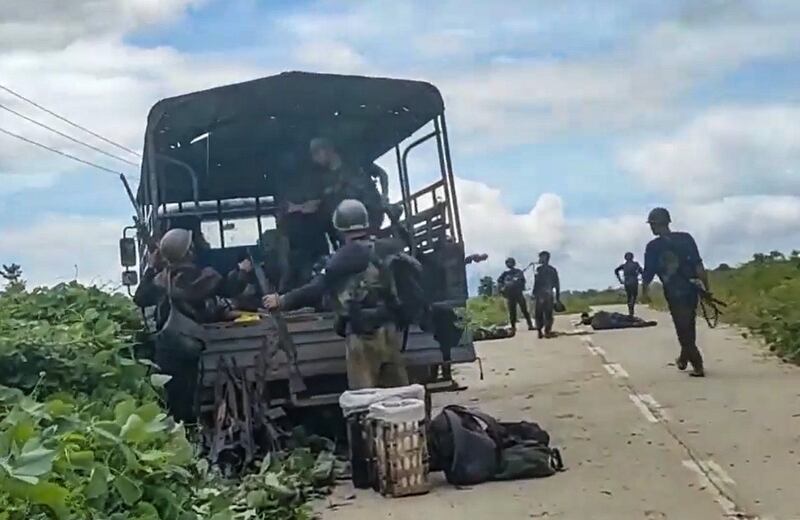Holed up in his palace in Naypyitaw, Myanmar Senior Gen. Min Aung Hlaing, must be apoplectic.
Over two years since seizing power in the Feb. 1, 2021 coup, the military has still not consolidated power. Despite vowing to crush the opposition, the junta leader had to acknowledge recently that 132 of Myanmar’s 330 townships–42 percent–were not under government control.
The shadow opposition National Unity Government, their People’s Defense Forces (PDFs), and allied ethnic resistance organizations, have held their own and enjoy overwhelming popular legitimacy.
The military’s supply lines, through the once safe ethnic majority Bamar heartland, are increasingly vulnerable and casualties are mounting.

The exasperation of the leadership is palpable and manifest in several key ways.
First, the military has increased its attacks on civilians in an attempt to terrorize them into submission through collective punishments and reprisals. The military is waging a scorched earth campaign and has arsoned over 65,000 homes, 48,000 in Sagaing alone.
The regime has stepped up their use of air assaults, a glaring admission that they are unable to deploy troops on the ground. And when they do, they will often dragoon civilians to serve as human shields.
Second, the regime has increased their reliance on pro-military militias and death squads.
Third, so desperate to defeat the NUG this year, the military increased its own budget by 51 percent, despite the moribund economy and diminished revenue streams.
Fourth, the regime has increased its cash rewards for members of the PDFs to surrender with their weapons. These offers are clearly caveated and do not amount to blanket immunity, but the expenditures do factor in the soaring rates of poverty caused by the junta's mismanagement.

Fifth, when things are going badly, the military leadership tends to micromanage.
In February, Min Aung Hlaing met with the leadership of the Western Command in Rakhine. The following month, he made an inspection tour of the headquarters of the Northwest Command that is overseeing the campaigns in Sagaing and Chin States.
The previous month, the junta placed 14 townships in Sagaing, five in the Magway region, and four in Chin state under martial law.
These trips outside of Naypyitaw are all the more notable because Min Aung Hlaing rarely leaves the fortress capital, and he travels with a small army of bodyguards..
That’s no profile in courage compared to the NUG’s acting president, Duwa Lashi La, who has made multiple trips to visit front line troops.
Light Infantry Divisions
But an unappreciated sign of frustration is the rotation of commanders in the face of battlefield losses and failed offensives.
Myanmar’s military is divided into 14 different Regional Commands and six Bureaus of Special Operations.
Myanmar's military is smaller than often reported, roughly 150,000 soldiers, with the air force and navy adding 50-60,000 more personnel. Yet only 70,000 are frontline troops.

The majority of kinetic operations are conducted by 10 Light Infantry Divisions (LIDs), which should be about 20,000 men in total, divided into roughly 100 battalions.
The Light Infantry Battalions are the shock and awe troops. They are the best armed and equipped, the most mobile, and by far the most lethal. They are operating at a decreased levels. According to Ye Myo Hein, the majority of these are under 150 men each, well below the already lowered 200-man floor.
They are the troops that the regime has relied on to achieve its strategic goals, including the 2017-2018 ethnic cleansing of the Rohingya. Today the 99th LID's such as the " Ogre Column" in Sagaing do the bulk of the scorched earth operations against civilians.
The majority of forces are territorial, and deployed in static and defensive positions, where they are increasingly surrounded and harassed by PDFs and EROs. Their resupply of food, munitions, and fuel is increasingly perilous and sporadic.
Estimates of the current strength of LIDs, given a conservative casualty rate of 15 percent, is around 16-17,000 men. Recruitment has slowed and the operational tempo for the troops is unsustainable.
All of this compounds poor battlefield performance and the frustration of the leadership.
Even fewer restraints in targeting
One of the most important indicators of the regime’s frustration is rotation of operational commanders.
Between February 2021 and July 2022, only two of the 14 regional military commanders were rotated. In August 2022, five were replaced. Since then, four more others were rotated out, including Major General Myat Thet Oo, the Southeastern Commander in March 2023. Two other lieutenant generals, Khin Hlaing and Thant Hlaing who oversaw operations in Karen and Sagaing States were sacked in February-March 2022.
Since October 2022, three commanders of the six Bureaus of Special Operations, all lieutenant generals, have likewise been rotated out.
At the operational level, there have been fewer rotations in the past six months than expected. The 11th LID commander was promoted to be the commander of the Southeast Regional Military Command. But the heads of the 44th and 77th were transferred to non-operational billets. The commander of the 88th LID had a horizontal transfer to the 77th.
Part of this is the annual reshuffle, though the tempo has increased in the past six months.
Almost all of these officers moved on to non-operational positions including at the Myanmar Economic Corporation or the Defense Services Technological Academy. The junta is careful to make sure all get soft landings.

Issues around the rotation of operational level leaders are compounded by battlefield losses, which are not insignificant. Between January 2023 and mid-May, 20 mid-level officers were killed, including four colonels, six lieutenant colonels, and 10 majors, based on open source reporting.
While a sign of frustration, the rotation of commanders is bad news for Myanmar’s people. The replacements will be even more sycophantic and slavish to the State Administrative Council leadership. Zealotry and a desire to prove themselves will lead to even fewer restraints in targeting.
While the NUG has outperformed militarily, it’s incumbent that the regime’s colonels and one-star generals–the people who actually have to execute the war and who are not getting their cut of the windfall of plundered wealth that the leaders of the SAC are taking for themselves–realize that the war cannot be won.
The rotation of commanders should be a further reminder, not just a sign of the leadership’s exasperation.
Zachary Abuza is a professor at the National War College in Washington and an adjunct at Georgetown University. The views expressed here are his own and do not reflect the position of the U.S. Department of Defense, the National War College, Georgetown University or Radio Free Asia.
